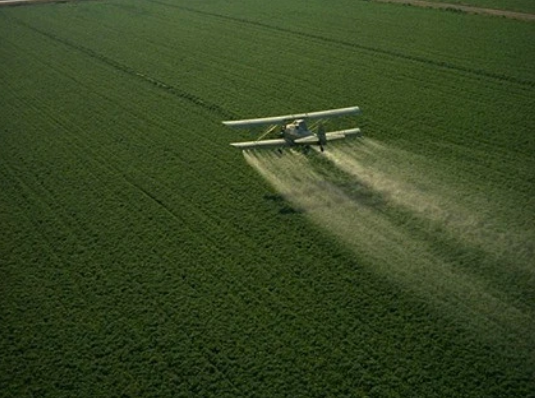The Great Green Hype
Craig Holdrege
From In Context #6 (Fall, 2001)
In August, a public radio station in Urbana, Illinois, asked me for an interview after a staff person had read Steve's and my article on genetic engineering and agriculture in Sierra. The station had previously interviewed a proponent of genetic engineering and now they wanted to hear the other side. It was a call-in show and became especially engaged when an Illinois farmer called in who felt that anti-biotech activists (among whom he counted me) were out to ruin farmers. He said, in effect, “Tell me what to do. I grow a thousand acres of soybeans and plant Roundup Ready soybeans [genetically engineered, herbicide-resistant soybeans sold by Monsanto, which also produces the herbicide "Roundup]. I can't grow a thousand acres of soybeans without herbicide; that wouldn't work. But I use less herbicide than I have previously, which is good for the environment. And I save money. What's wrong with that? I'm demonized for doing this by you activists. You tell me what to do.”
I couldn't help sympathizing with the farmer. He was genuine in his frustration, feeling as he did that his industrial agricultural practices were less environmentally harmful, and all he gets is criticism from environmentalists. He felt “damned if I do and damned if I don't.” Nonetheless I couldn't agree with his reading of the situation. I suggested that he was more a victim of prevailing agricultural economics — driven by the unhealthy pairing of the biotech industry with the government — than he was of activists. I'm not convinced he heard or believed what I said.
I'd just been reading studies that indicate the amount of herbicides farmers are spraying is, overall, not declining and is in many cases rising (Benbrook 2001). One reason may be, as agricultural consultant Charles Benbrook states, that “intense herbicide price competition, triggered by the commercial success of Roudup Ready soybeans, has reduced the average cost of today's popular herbicides by close to fifty percent since the introduction of Roundup Ready soybeans. In response farmers are applying more active ingredients at generally higher rates” (Benbrook, 2001, p. 3). (Most industrial farmers like a “clean field.”) A similar case is Bt-Corn, which is genetically modified to produce its own insecticide. Although between 20 and 30 percent of all corn grown in the United States is Bt-Corn, there has been no overall drop in the amount of insecticides sprayed on cornfields since 1996, when Bt-Corn was introduced (Obrycki 2001). This certainly doesn't look environmentally-friendly to me, especially, since we have to add to these amounts the pesticides that the plants themselves are producing. As Steve and I pointed out in our Sierra article, this plant-derived increase in the use of poisons is never added into the standard calculations.
There are other problems with genetically-modified crops. Benbrook points out that Roundup Ready soybeans produce five to ten percent fewer bushels per acre compared to traditional varieties grown under comparable conditions. This so-called yield drag is at least in part due to a weakening of the roots and nitrogen fixation in Roundup Ready soybeans, which makes them especially susceptible to drought. There is also evidence of weaker plant defense against pests. In Canada, a wholly different kind of problem is surfacing: farmers are complaining about genetically modified, herbicide-resistant Canola, which is spreading as a weed in the fields of other crops like wheat; their favorite herbicide — Roundup — won't kill it!
Of course, individual farmers, like the one who called in, may be well satisfied with their product (at least for the time being). But they have become indoctrinated into the industrial agriculture paradigm, which says bigger and more uniform is always better, as long as it appears more profitable. That's why the farmer couldn't imagine growing soybeans organically. He'd probably have to give up his monoculture and plant different varieties, and give attention to building up soil rather than sterilizing it with poisons. He'd probably also lose government subsidies. This farmer was not willing to entertain such a possibility. His answer: it just won't work — the standard answer we give when we're afraid of revolutionary developments.
In preparing for this interview, I came across a quote that spoke volumes. Dan Glickman, the Agriculture Department Secretary under President Clinton and a vocal proponent of genetically modified crops and food, was reflecting back on his time as Secretary. He stated, “[Government] regulators even viewed themselves as cheerleaders for biotechnology. It was viewed as science marching forward, and anyone who wasn't marching forward was a luddite.” In other words, the biotech industry was running the government regulation (or, rather, the nonregulation) of genetically modified crops and foods. The reporter who interviewed Glickman summarizes, “Looking back now, he regrets that industry was allowed to take the lead, as regulators ceded their watchdog role” (Los Angeles Times, July 1, 2001).
And we're living with the consequences. Seventy-five percent of food in the supermarket today contains genetically modified products. There has been almost no government regulation—as opposed to cheerleading—and no policy to require labeling, which would at least acknowledge the right of consumers to know where their food comes from. Both the biotech industry and government scientists have duped farmers into thinking that biotech farming is not only profitable (“profitable for whom?”we ask, since most industrial farmers rely on government subsidies), but also good for the environment and necessary for feeding the world.
The genuine vexation of my farmer-interrogator is a good measure of the educational challenge The Nature Institute has taken on.
References
Benbrook, Charles M. (2001). “Troubled Times Amid Commercial Success for Roundup Ready Soybeans.” AgBioTech InfoNet Technical Paper Number 4. (www.biotech-info.net/troubledtimes.html)
Obrycki, John J. et al. (2001). “Transgenic Insecticidal Corn: Beyond Insecticidal Toxicity to Ecological Complexity.” Bioscience 5: 353-361.

